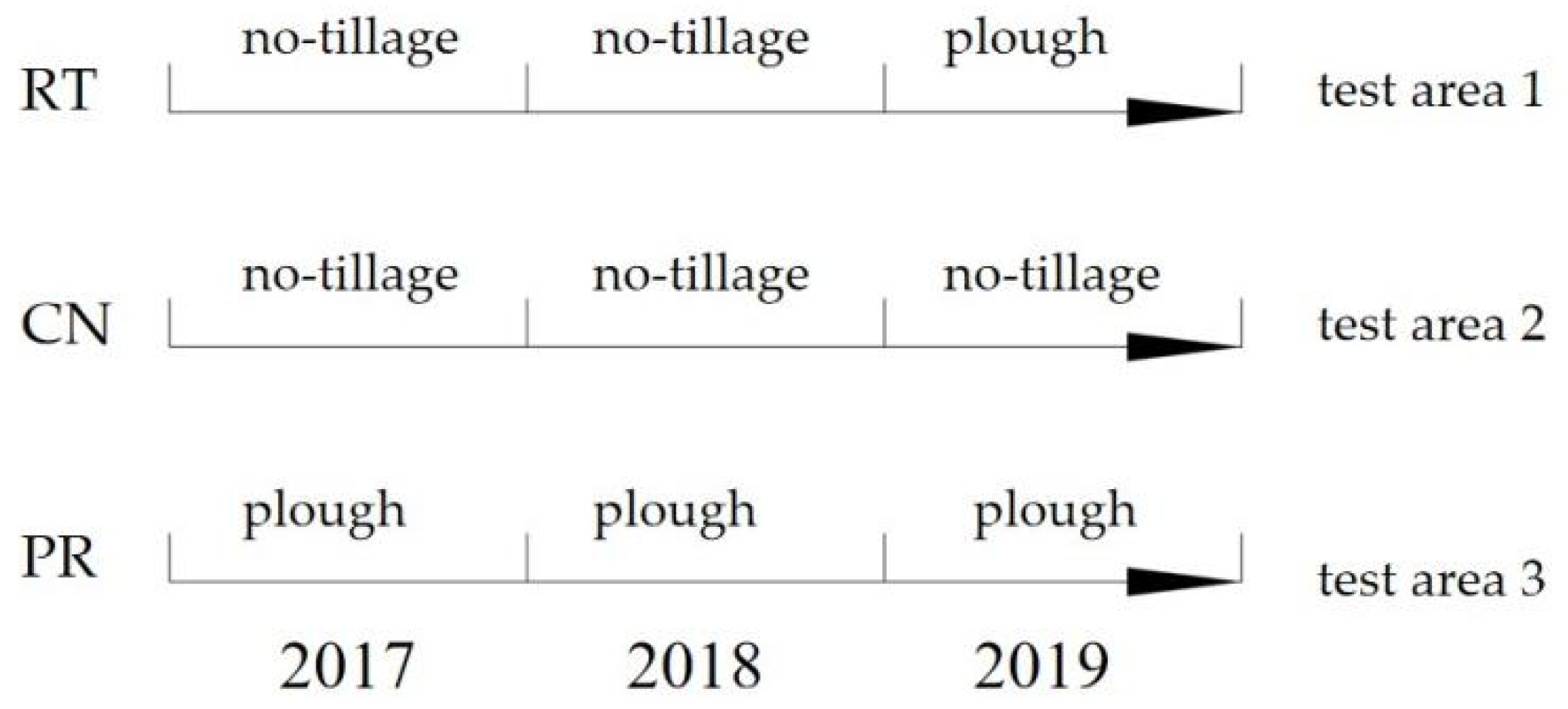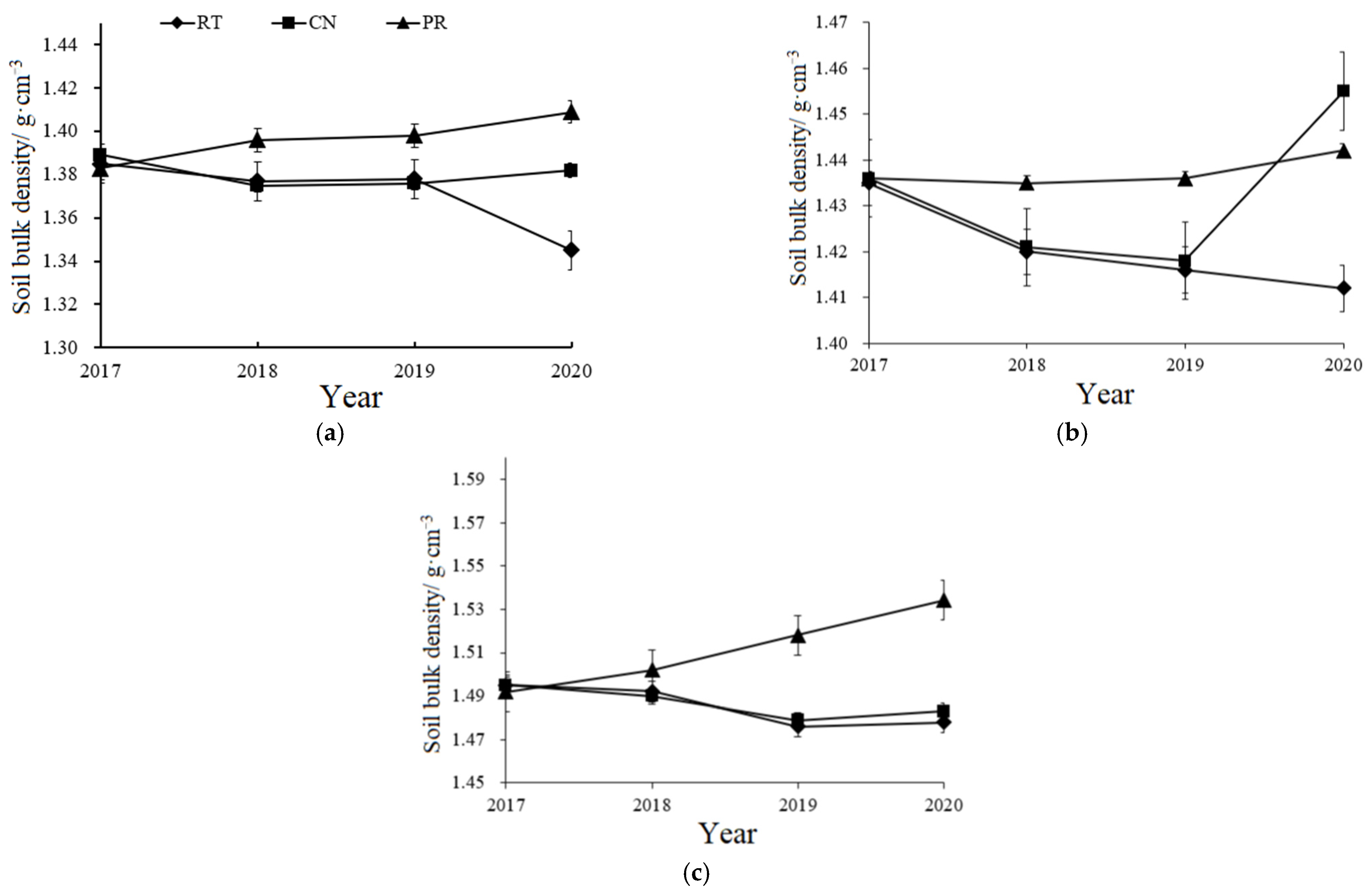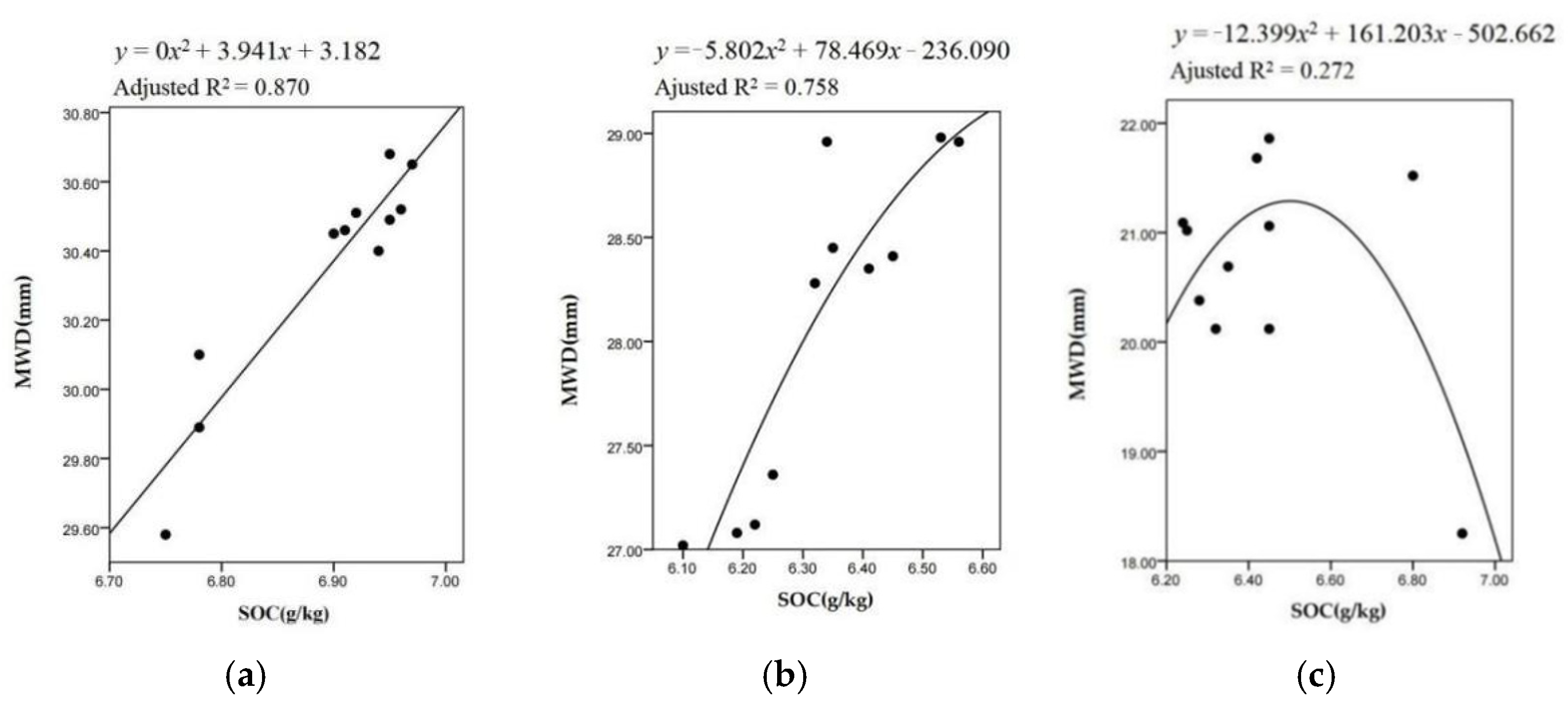Effects of Rotational Tillage on Soil Physicochemical Properties and Crop Yield in a Rice–Wheat Double Cropping Area
Abstract
:1. Introduction
2. Materials and Methods
2.1. Overview of Test Area
2.2. Experimental Scheme
2.3. Materials
2.4. Test Items and Methods
2.4.1. Methods for Soil Sampling and Determination
2.4.2. Methods of Crop Yield Factor Determination
2.4.3. Measuring Methods for Crop Yield Components
2.4.4. Data Processing and Statistical Analysis
3. Results and Analysis
3.1. Effects of Different Tillage Methods on Soil Structure
3.1.1. Effects on Soil Aggregate
3.1.2. Effects on Soil Bulk Density
3.2. Effects of Different Tillage Patterns on Soil Nutrient Content
3.2.1. Effects on Soil N, P, and K Contents
3.2.2. Effects on Soil Organic Carbon Content
3.2.3. Regression Analysis of Soil Organic Carbon Content and Macroaggregate Stability
3.3. Effect of Tillage Systems on Crop Yield
4. Discussion
5. Conclusions
Author Contributions
Funding
Institutional Review Board Statement
Informed Consent Statement
Data Availability Statement
Conflicts of Interest
References
- Jacobs, A.; Helfrich, M.; Hanisch, S.; Quendt, U.; Rauber, R.; Ludwig, B. Effect of conventional and minimum tillage on physical and biochemical stabilization of soil organic matter. Biol. Fertil. Soils 2010, 46, 671–680. [Google Scholar] [CrossRef] [Green Version]
- Zhang, Y.P.; Chi, Y.J.; Wang, Z.B.; Li, X.R.; Li, H.W.; Diao, P.S. Comprehensive evaluation of periodic productivity of combined tillage mode in wheat-maize double cropping areas. Trans. Chin. Soc. Agric. Eng. 2020, 36, 35–43. [Google Scholar]
- Zhang, H.H.; Zhang, Y.Q.; Yan, C.R.; Liu, E.K.; Chen, B.Q. Soil nitrogen and its fractions between long-term conventional and no-tillage systems with straw retention in dryland farming in northern China. Geoderma 2016, 269, 138–144. [Google Scholar] [CrossRef]
- Hong, Y.H.; Zhao, D.; Zhang, F.Z.; Shen, G.N.; Yuan, Y.; Gao, Y.M.; Yan, L.; Wei, D.; Wang, W.D. Soil water-stable aggregates and microbial community under long-term tillage in black soil of Northern China. Ecotoxicology 2021, 30, 1754–1768. [Google Scholar] [CrossRef]
- Tang, W.G.; Xiao, X.P.; Tang, H.M.; Zhang, H.L.; Chen, F.; Chen, Z.D.; Xue, J.F.; Yang, G.L. Effects of long-term tillage and rice straw returning on soil nutrient pools and Cd concentration. J. Appl. Ecol. 2015, 26, 168–176. [Google Scholar]
- Luo, Z.Z.; Gan, Y.T.; Niu, Y.N.; Zhang, R.Z.; Li, L.L.; Cai, L.Q.; Xie, J.H. Soil quality indicators and crop yield under long-term tillage systems. Exp. Agric. 2017, 53, 497–511. [Google Scholar] [CrossRef]
- Liu, W.; Zhang, G.Y.; Zhang, J.; Liu, L.; Huang, L.; Lu, J.W. Effects of Two Conservation Tillage Measures on Soil Aggregate Stability. J. Soil Water Conserv. 2015, 29, 117–122. [Google Scholar]
- Gao, H.J.; Peng, C.; Zhang, X.Z.; Li, Q.; Jia, L.H.; Zhu, P. Effects of Different Straw Returning Modes on Characteristics of Soil Aggregates in Chernozem Soil. J. Soil Water Conserv. 2019, 33, 75–79. [Google Scholar]
- Sheehy, J.; Regina, K.; Alakukku, L.; Six, J. Impact of no-till and reduced tillage on aggregation and aggregate-associated carbon in Northern European agroecosystems. Soil Tillage Res. 2015, 150, 107–113. [Google Scholar] [CrossRef]
- Tian, S.Z.; Ning, T.Y.; Wang, Y.; Liu, Z.; Li, G.; Li, Z.J.; Lal, R. Crop yield and soil carbon responses to tillage method changes in North China. Soil Tillage Res. 2016, 163, 207–213. [Google Scholar] [CrossRef]
- Zhang, Y.F.; Sun, G.F.; Zhou, W.; Hu, Y.R.; Wang, X.; Chen, L.G.; Zheng, J.C. Effects of conservation tillage on soil carbon pool from high production rice-wheat double cropping systems in South China. Southwest-China J. Agric. Sci. 2015, 28, 1155–1160. [Google Scholar]
- Zhang, Y.P.; Wang, Z.W.; Diao, P.S.; Du, R.C.; Li, H.W.; Yao, W.Y. Short-term effects of mechanical and ecological tillage pattern on physical and chemical characteristics of soil in arid area. Trans. Chin. Soc. Agric. Mach. 2018, 49, 45–55. [Google Scholar]
- Du, Z.L.; Ren, T.S.; Hu, C.S.; Zhang, Q.Z. Transition from intensive tillage to no-till enhances carbon sequestration in microaggregates of surface soil in the North China Plain. Soil Tillage Res. 2015, 146, 26–31. [Google Scholar] [CrossRef]
- Zhang, Q.; Wang, S.L.; Sun, Y.G.; Zhang, Y.H.; Li, H.Y.; Liu, P.Z.; Wang, X.L.; Wang, R.; Li, J. Conservation tillage improves soil water storage, spring maize (Zea mays L.) yield and WUE in two types of seasonal rainfall distributions. Soil Tillage Res. 2022, 215, 105237. [Google Scholar] [CrossRef]
- Cheng, J.P.; Wu, J.P.; Luo, X.W.; Fan, Q.Z.; Zhang, G.Z.; Zhou, Z.Y.; Zang, Y.; Yang, B.B. Influence of different planting methods on growth characteristics and yield of early rice. Hubei Agric. Sci. 2011, 50, 457–460. [Google Scholar]
- Farooq, M.; Siddique, K.H.; Rehman, H.; Aziz, T.; Lee, D.J.; Wahid, A. Rice direct seeding: Experiences, challenges and opportunities. Soil Tillage Res. 2011, 111, 87–98. [Google Scholar] [CrossRef]
- Gupta, R.K.; Hussain, A.; Sooch, S.S.; Kang, J.S.; Sharma, S.; Dheri, G.S. Rice straw biochar improves soil fertility, growth, and yield of rice–wheat system on a sandy loam soil. Exp. Agric. 2020, 56, 118–131. [Google Scholar] [CrossRef]
- Hossain, M.I.; Ohab, M.A.; Sheikh, M.H.R.; Nag, B.L. Different Tillage Options and Residue Management for Improving Crop Productivity and Soil Fertility in Wheat-Maize-Rice Cropping Pattern. Bangl. Agron. J. 2019, 22, 55–66. [Google Scholar] [CrossRef]
- Zhang, Y.P.; Du, R.C.; Diao, P.S.; Yang, S.D. Experiment of no-tillage and drought direct sowing rice and feasibility analysis in Shandong Province. Trans. Chin. Soc. Agric. Eng. 2016, 32, 24–30. [Google Scholar]
- Zhang, Y.P.; Du, R.C.; Diao, P.S.; Yang, S.D.; Wang, Z.W. Design and experiment of wide band seeding rice seeder with reversed stubble cleaning and anti-blocking. Trans. Chin. Soc. Agric. Eng. 2017, 33, 7–13. [Google Scholar]
- Song, K.; Yang, J.J.; Xue, Y.; Lv, W.G.; Zheng, X.Q.; Pan, J.J. Influence of tillage practices and straw incorporation on soil aggregates, organic carbon, and crop yields in a rice-wheat rotation system. Sci. Rep. 2016, 6, 36602. [Google Scholar] [CrossRef] [PubMed]
- Six, J.; Elliott, E.T.; Paustian, K.; Doran, J.W. Aggregation and soil organic matter accumulation in cultivated and native grassland soils. Soil Sci. Soc. Am. J. 1998, 62, 1367–1377. [Google Scholar] [CrossRef] [Green Version]
- Martins, M.D.R.; Angers, D.A.; Corá, J.E. Carbohydrate Composition and Water-Stable Aggregation of an Oxisol as Affected by Crop Sequence under No-Till. Soil Sci. Soc. Am. J. 2012, 76, 475–484. [Google Scholar] [CrossRef]
- Bottinelli, N.; Angers, D.A.; Hallaire, V.; Michot, D.; Le Guillou, C.; Cluzeau, D.; Heddadj, D.; Menasseri-Aubry, S. Tillage and fertilization practices affect soil aggregate stability in a Humic Cambisol of Northwest France. Sci. Rep. 2017, 170, 14–17. [Google Scholar] [CrossRef]
- Yin, T.; Zhao, C.X.; Yan, C.R.; Du, Z.L.; He, W.Q. Inter-annual changes in the aggregate-size distribution and associated carbon of soil and their effects on the straw-derived carbon incorporation under long-term no-tillage. J. Integr. Agric. 2018, 17, 2546–2557. [Google Scholar] [CrossRef] [Green Version]
- Ferreira, C.J.B.; Tormena, C.A.; Severiano, E.D.C.; Zotarelli, L.; Betioli Júnior, E. Soil compaction influences soil physical quality and soybean yield under long-term no-tillage. Arch. Agron. Soil Sci. 2021, 67, 383–396. [Google Scholar] [CrossRef]
- Wang, H.H.; Li, X.; Li, X.; Wang, J.; Li, X.Y.; Guo, Q.; Yu, Z.X.; Yang, T.T.; Zhang, H.W. Long-term no-tillage and different residue amounts alter soil microbial community composition and increase the risk of maize root rot in northeast China. Soil Tillage Res. 2020, 196, 104452. [Google Scholar] [CrossRef]
- Briedis, C.; de Moraes Sá, J.C.; Caires, E.F.; de Fátima Navarro, J.; Inagaki, T.M.; Boer, A.; Neto, C.Q.; de Oliverira Ferreira, A.; Canalli, L.B.; Dos Santos, J.B. Soil organic matter pools and carbon-protection mechanisms in aggregate classes influenced by surface liming in a no-till system. Geoderma 2012, 170, 80–88. [Google Scholar] [CrossRef]
- Wu, J.; Guo, X.S.; Wang, Y.Q.; Xu, Z.Y.; Lu, J.W. Effects of tillage patterns on crop yields and soil physicochemical properties in wheat-rice rotation system. Trans. Chin. Soc. Agric. Eng. 2012, 28, 87–93. [Google Scholar]




| Parameter | Numerical Value |
|---|---|
| Soil type | Retention of fertile paddy soil |
| pH | 6.8 |
| average organic carbon of 0~30 cm soil layer (g/kg) | 5.75 |
| total nitrogen (g/kg) | 0.95 |
| alkaline hydrolysis nitrogen (mg/kg) | 82.43 |
| available phosphorus (mg/kg) | 34.30 |
| rapidly available potassium (mg/kg) | 73.10 |
| average bulk density (g/cm3) | 1.423 |
| Soil Sample Depth (cm) | Treatment | R > 0.25 (%) | MWD (mm) | K (%) | ||
|---|---|---|---|---|---|---|
| Mechanical Stability | Water Stability | Mechanical Stability | Water Stability | |||
| 0~10 | RT * | 76.43a | 30.52a | 3.01a | 0.48b | 60.07b |
| CN ** | 77.41a | 31.44a | 3.24a | 0.54a | 59.39b | |
| PR *** | 64.53b | 22.38b | 2.21b | 0.38c | 65.32a | |
| 10~20 | RT | 71.57a | 28.41a | 2.88a | 0.40a | 60.30b |
| CN | 68.62b | 26.26b | 2.59b | 0.32b | 61.73a | |
| PR | 70.12a | 27.88a | 2.76a | 0.38a | 60.24b | |
| 20~30 | RT | 69.92a | 26.31a | 2.48a | 0.34a | 62.37c |
| CN | 63.86b | 22.23b | 2.17b | 0.27b | 65.19b | |
| PR | 55.76c | 18.82c | 2.11c | 0.21c | 66.25a | |
| Depth (cm) | Treatments | Total Nitrogen (g/kg) | Alkali Hydrolyzed Nitrogen (mg/kg) | Available Phosphorus (mg/kg) | Available Potassium (mg/kg) | Organic Carbon (g/kg) |
|---|---|---|---|---|---|---|
| 0~10 | RT | 1.12a | 92.05a | 38.84a | 105.24a | 6.96a |
| CN | 1.18a | 93.21a | 36.28b | 106.36a | 6.98a | |
| PR | 0.96 b | 91.42a | 32.54b | 102.55b | 6.32b | |
| 10~20 | RT | 0.99a | 89.21a | 35.98a | 98.32a | 6.85a |
| CN | 0.82b | 87.05a | 32.60a | 90.56b | 6.25b | |
| PR | 0.97 a | 88.00a | 35.68a | 99.47a | 6.92a | |
| 20~30 | RT | 0.94a | 90.21a | 33.98a | 96.32a | 6.65a |
| CN | 0.78b | 75.05b | 26.40b | 80.56b | 5.92b | |
| PR | 0.68c | 60.00c | 23.68c | 69.47c | 5.65c |
| Treatment | Effective Panicles (106·ha) | Spike Length (cm) | Grain Number Per Spike | Seed Setting Rate (%) | Thousand-Grain Weight (g) | Actual Output (kg·ha) |
|---|---|---|---|---|---|---|
| RT | 4.22b | 13.2a | 90b | 93b | 26.5a | 8 970a |
| CN | 4.41a | 12.8b | 88b | 92b | 24.6b | 7 866b |
| PR | 3.81c | 13.9a | 98a | 96a | 27.3a | 9 020a |
| Treatment | Basic Seedling (106·ha) | Average Tiller Per Plant | Effective Panicles (106·ha) | Effective Number of Grains Per Spike | Thousand- Grain Weight (g) | Actual Output (kg·ha) |
|---|---|---|---|---|---|---|
| RT | 1.65a | 3.75a | 5.95a | 34.2a | 45.2a | 7818 a |
| CN | 1.63a | 3.59b | 5.87b | 32.5b | 43.6b | 7073 b |
| PR | 1.62a | 3.42c | 5.78b | 32.3b | 42.8c | 6898 b |
Disclaimer/Publisher’s Note: The statements, opinions and data contained in all publications are solely those of the individual author(s) and contributor(s) and not of MDPI and/or the editor(s). MDPI and/or the editor(s) disclaim responsibility for any injury to people or property resulting from any ideas, methods, instructions or products referred to in the content. |
© 2022 by the authors. Licensee MDPI, Basel, Switzerland. This article is an open access article distributed under the terms and conditions of the Creative Commons Attribution (CC BY) license (https://creativecommons.org/licenses/by/4.0/).
Share and Cite
Zhang, Y.-P.; Li, X.; He, H.-J.; Zhou, H.; Geng, D.-Y.; Zhang, Y.-Z. Effects of Rotational Tillage on Soil Physicochemical Properties and Crop Yield in a Rice–Wheat Double Cropping Area. Sustainability 2023, 15, 474. https://doi.org/10.3390/su15010474
Zhang Y-P, Li X, He H-J, Zhou H, Geng D-Y, Zhang Y-Z. Effects of Rotational Tillage on Soil Physicochemical Properties and Crop Yield in a Rice–Wheat Double Cropping Area. Sustainability. 2023; 15(1):474. https://doi.org/10.3390/su15010474
Chicago/Turabian StyleZhang, Yin-Ping, Xin Li, Hao-Jie He, Hua Zhou, Duan-Yang Geng, and Yu-Zi Zhang. 2023. "Effects of Rotational Tillage on Soil Physicochemical Properties and Crop Yield in a Rice–Wheat Double Cropping Area" Sustainability 15, no. 1: 474. https://doi.org/10.3390/su15010474





